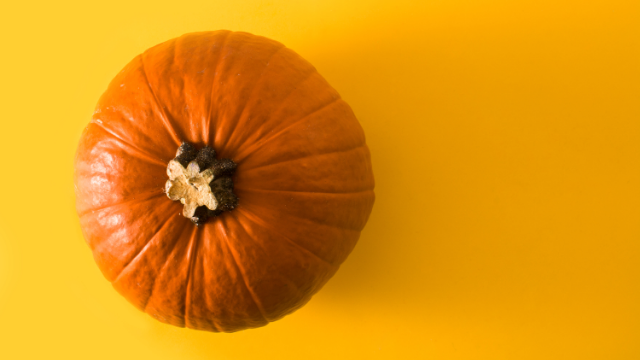
Nothing ushers in the fall season like pumpkins. I’ve always seen them as the mascot of autumn, bright and festive and fun – not to mention delicious and packed full of nutrition. A cup of cooked pumpkin is loaded with vitamins A and C and is a powerhouse of potassium.
Like carrots and butternut squash, pumpkins boast the antioxidant beta-carotene. Beta-carotene is a member of the carotenoids, which are highly pigmented fat-soluble compounds naturally present in many fruits and vegetables (leafy greens, carrots, sweet potatoes, squash, bell peppers, apricots and mangoes, to name a few).
The human body converts beta-carotene into vitamin A, an essential nutrient, and has antioxidant activity, which helps to protect cells from damage. A cup of cooked pumpkin contains more than 200% of your recommended daily intake of vitamin A.
How to Choose a Pumpkin
Field pumpkins, which are great for carving perfect jack-o’-lanterns, tend to be too large and stringy for baking. Choose a smaller variety for cooking such as a sugar or pie pumpkins, as they have denser flesh, more flavor and a smooth texture.
When choosing a pumpkin, let your senses guide you. Look for a pumpkin that has a rich orange color with skin that cannot be easily broken or scratched by your fingernail. Feel for a smooth surface and dry rind.
If you are planning to store it for more than a few days, be sure to choose a pumpkin that has one or two inches of stem left, as pumpkins with shorter stems decay more quickly.
Try picking up a few different pumpkins and choose one that feels heavy for its size. For every pound of whole pumpkin, you can expect to get one cup of pumpkin puree.

How to Roast Pumpkin
One of the easiest and simplest ways to serve pumpkin is to roast it. You can serve the roasted pumpkin as-is, or use the roasted pumpkin as an ingredient in other recipes. Here’s how:
- Wash pumpkin to remove any dirt or debris
- Cut the pumpkin in half, and discard the stem section and stringy pulp
- In a shallow baking dish, place the two halves face down and add about ¼ inch of water
- Bake at 350 degrees for about an hour or until tender (larger pumpkins may take a bit longer)
- Once the baked pumpkin has cooled, scoop out the flesh or just peel off the rind
- Chop, puree or mash the roasted pumpkin as desired, then serve!
Pumpkin Harvest Rice Recipe
This is a great pumpkin recipe that’s totally Gerson Therapy-friendly. Brown rice or quinoa is permitted once per week for patients on the Gerson Therapy (you could try substituting quinoa for brown rice in this recipe, too!).
Makes about 6 cups
Ingredients
- 1 cup dry brown rice (or 2 cups cooked brown rice)
- 1 cup pureed pumpkin (see above for roasting instructions, then puree in food processor)
- 1 1/2 tbsp raw apple cider vinegar
- 1 tbsp maple syrup
- 1 small fuji apple, diced
- 1 small sweet onion, diced
- 2 tbsp minced fresh parsley
- 1/4 cup organic raisins, soaked in water overnight to re-hydrate
Preparation
- Cook brown rice normally (boil 1 cup rice in 2 cups water) and set aside in large mixing bowl.
- Roast pumpkin, per instructions above, and puree in food processor
- In a small bowl, combine the pumpkin, maple syrup and apple cider vinegar. Mix well. Add this mixture to the warm brown rice. Fold until well distributed.
- Fold diced onions, diced apples and fresh parsley.
Serve warm or keep in warm oven until ready to serve. Do not overheat, as you want the apples and onions to still be a bit crisp. Enjoy!
This article was originally published in November 2013 and has been updated for relevancy.



Comment1
Doesn’t the body need some kind of fat-containing substance to convert the beta-caroteen in vitamine A? I was always told to eat or boil carrots or pumpkin with a small amount of butter or coconut fat to make sure the nutrients in the verggies are better absorbed by the body. Thank you!
Comments are closed.